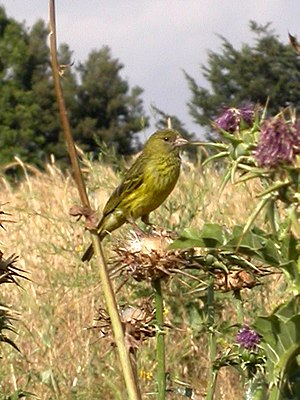Thin-billed girlitz
| Thin-billed girlitz | ||||||||||||
|---|---|---|---|---|---|---|---|---|---|---|---|---|

Thin-billed girlitz ( Crithagra citrinelloides ) |
||||||||||||
| Systematics | ||||||||||||
|
||||||||||||
| Scientific name | ||||||||||||
| Crithagra citrinelloides | ||||||||||||
| ( Rüppell , 1840) |
The thin-billed girlitz ( Crithagra citrinelloides , Syn . : Serinus citrinelloides ) is a species of finch from the goldfinch-like subfamily . The species is occasionally kept in Europe as an ornamental bird.
There are two subspecies. The IUCN classifies the thin-billed girl as not endangered ( least concern ).
description
The thin-billed girl seat reaches a body length of twelve to thirteen centimeters. The male is blackish with green-fringed feathers on the upper side of the body. The eye stripes are yellow, the face mask greyish to blackish. The throat is lightened white-gray, the underside of the body is otherwise yellow with dark dashes. The beak is pointed. The female is gray-green in the face, the breast and the flanks are yellowish with a gray dash. The calls and singing of the thin-beaked girl are similar to those of the Kanarengirlitz .
distribution and habitat
The distribution area of the Dünnschnabelgirlitz is the south of Sudan as well as Ethiopia and Eritrea . It is a mountain bird that occurs there in the high areas. In Eritrea, for example, it is locally common on plateaus at altitudes between 2,200 and 2,300 meters. Occasionally it even occurs at altitudes of up to 2,750 meters. It is sometimes a very common bird and can be found regularly in places where cosmos and plants of the daisy genus Aspilia are common.
Its habitats are open bush in the highlands, the edges and clearings of moist forest areas and the banks of lakes and rivers. In addition, it has opened up the human settlement area and occurs in fields and gardens.
Way of life
The thin-beaked girl mainly lives in small groups of ten to 30 individuals. He looks for his food mainly on the ground. He also picks the seeds from the dried flower heads of aspilia and cosmos . He cleverly frees seeds from their seed coat with his beak. In addition to the seeds of daisy plants, it also eats millet and grass seeds as well as ripe berries of cordia , certain types of star bushes , convertible florets , black nightshade and the Peruvian pepper tree . It also pecks at strawberries, raspberries and grapes and eats the buds and leaves of certain types of dock . Occasionally he also hunts flying termites. It also eats ants, beetles, grasshopper larvae and caterpillars.
The clutch is incubated by the female for 14 days. During the first incubation days, it leaves the nest relatively frequently, but the breeding breaks become increasingly shorter as the incubation period increases. During this time, the male often brings food, the female begs with trembling wings and pecks the food out of its beak in small quantities. The newly hatched chicks are hovered almost continuously by the female for the first three days. The male also participates in the feeding of the young with increasing intensity. The nestling period is 15 to 16 days. The young birds stay with the family for about four weeks.
Internal system
There are two subspecies:
- the nominate form Crithagra citronelloides citronelloides occurs in the highlands of Eritrea and Ethiopia.
- the subspecies Crithagra citronelloides kikuyensis is common in the highlands of Kenya . The male of this subspecies differs from those of the nominate form by the wider over-eye stripe. The top of the body is also greener than in the nominate form and has more noticeable longitudinal stripes. The female is a little more brown.
literature
- Horst Bielfeld : Knowing and caring for 300 ornamental birds. Ulmer Verlag, Stuttgart 2009, ISBN 978-3-8001-5737-2 .
- C. Hilary Fry and Stuart Keith (Eds.): The Birds of Africa. Volume VII. Christopher Helm, London 2004, ISBN 0-7136-6531-9 .
Web links
- Crithagra citrinelloides inthe IUCN Red List of Threatened Species 2017.3. Posted by: BirdLife International, 2016. Retrieved January 26, 2017.